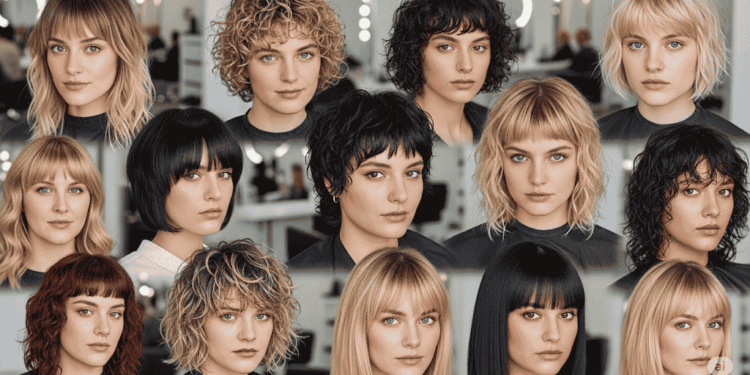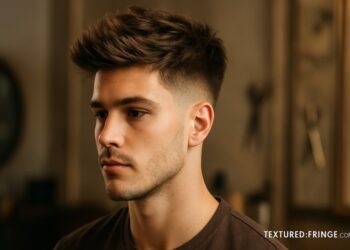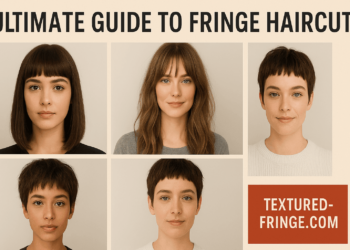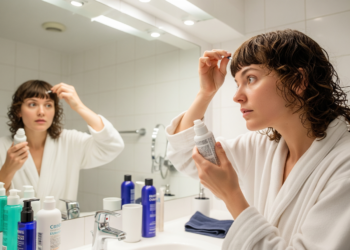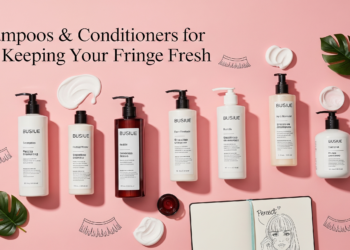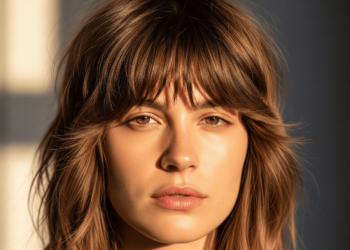Fringe hairstyles are having their biggest moment yet in 2025, and honestly, I couldn’t be more excited about it! After years of growing out my own bangs (a pandemic decision I’m still recovering from), I’ve been watching the textured fringe trend explode across social media and red carpets. There’s something so refreshing about how these styles break away from the perfectly straight, blunt cuts we’ve seen dominating for years.
What makes 2025’s fringe styles special isn’t just their popularity – it’s the incredible texture and movement they bring to your look. Whether you’re dealing with thick, stubborn hair like mine or fine strands that need some oomph, there’s a textured fringe style that’ll work for you.
Why Textured Fringes Are Taking Over in 2025
The beauty of textured fringes lies in their versatility and low-maintenance appeal. Unlike their predecessor styles that required daily straightening and precise styling, these modern cuts work with your hair’s natural texture rather than fighting against it. Celebrity stylists have been raving about how these cuts can instantly update any hairstyle, from long layers to short bobs.
1. The Curtain Fringe with Feathered Texture
This style’s been my personal favorite since I tried it last month. The curtain fringe parts naturally in the middle and features soft, feathered edges that blend seamlessly with longer layers. What I love most is how forgiving it is – even on those rushed mornings when I barely have time to run a brush through my hair, it still looks intentional.
The key to nailing this look is asking your stylist to cut the fringe while your hair is dry. This technique ensures the natural fall and movement look authentic to your hair’s texture.
2. Choppy Micro Fringe
For those who want to make a statement, the choppy micro fringe delivers serious edge. This ultra-short fringe sits well above the eyebrows and features deliberately uneven, textured ends. It’s definitely not for everyone (my sister tried it and immediately regretted it), but when it works, it’s absolutely stunning.
Best suited for oval and heart-shaped faces, this style pairs beautifully with sleek bobs or edgy pixie cuts.
3. Wispy Side-Swept Fringe
Sometimes the most elegant solutions are the simplest ones. The wispy side-swept fringe offers a softer approach to the trend, with delicate, textured pieces that graze the forehead at an angle. I’ve recommended this style to countless friends because it’s so universally flattering.
This cut works particularly well for women with fine hair, as the wispy texture creates the illusion of fuller, thicker strands around the face.
4. Shaggy Fringe with Lived-In Texture
The shag revival continues strong into 2025, and the shaggy fringe is leading the charge. This style features multiple layers within the fringe itself, creating incredible movement and dimension. It’s got that perfectly imperfect, just-rolled-out-of-bed vibe that somehow looks effortlessly chic.
The beauty of this cut is its ability to grow out gracefully. As someone who’s terrible at keeping up with regular trims, I appreciate a style that looks intentional even when it’s getting a bit long.
5. Textured Baby Bangs
Baby bangs are back, but they’re softer than their Y2K predecessors. The 2025 version features subtle texture and slight unevenness that prevents them from looking too harsh or geometric. They’re still dramatic, but in a more wearable way.
These work best on women with strong facial features and can actually help balance a larger forehead or prominent cheekbones.
6. Piecey Fringe with Razor-Cut Edges
Created using razor-cutting techniques, this fringe style features separated, piece-y sections that move independently. It’s incredibly modern and adds serious texture to any hairstyle. The razor cutting creates those perfectly imperfect edges that are so on-trend right now.
This style requires a skilled stylist who’s comfortable with razor techniques, so do your research before booking an appointment.
7. Soft Graduated Fringe
For those who want fringe but aren’t ready to commit to a dramatic change, the soft graduated fringe is perfect. The longest pieces sit near the temples while the center gradually shortens, creating a gentle arc across the forehead.
This style is incredibly forgiving for round faces and works beautifully with both straight and wavy hair textures.
8. Asymmetrical Textured Fringe
Bold and artistic, the asymmetrical textured fringe features an intentionally uneven length that’s longer on one side. It’s a statement piece that adds instant edge to any hairstyle. I’ve seen this look stunning on everything from shoulder-length hair to dramatic pixie cuts.
The key is ensuring the asymmetry looks intentional rather than accidental – something that requires an experienced stylist’s touch.
9. Bouncy Fringe for Curly Hair
Finally, a fringe style designed specifically for naturally curly and textured hair! This cut works with your curls’ natural spring and bounce rather than trying to force them into submission. The fringe is cut while curls are in their natural state, ensuring the perfect length and shape.
As someone with naturally wavy hair, I’m thrilled to see more inclusive cutting techniques that celebrate texture rather than fighting it.
10. Undone Fringe with Natural Movement
The undone fringe epitomizes the effortless beauty trend. It features subtle texture and natural-looking irregularities that suggest it wasn’t cut with a ruler and level. This style looks like you were born with perfect fringe – which is exactly the point.
It’s particularly stunning on women who embrace their hair’s natural texture and don’t mind a slightly tousled, lived-in look.
Styling Tips for Textured Fringes
Getting the cut is only half the battle – styling your textured fringe properly ensures it always looks its best. Here’s what I’ve learned from trial and error (mostly error, if I’m being honest):
For Daily Styling:
- Use a small round brush and blow-dry fringe forward and down
- Apply texturizing spray while hair is slightly damp
- Avoid over-brushing, which can flatten the texture
- Use dry shampoo on roots to add grip and volume
For Special Occasions:
- Use a flat iron to create subtle bends and movement
- Apply a light-hold texturizing paste for definition
- Consider using a diffuser for naturally textured hair
Maintenance and Care
Textured fringes require regular maintenance to keep looking fresh. Most styles need trimming every 4-6 weeks, though some of the more textured cuts can go longer between appointments.
I’ve found that investing in a good dry shampoo specifically for bangs has been a game-changer. It keeps them looking fresh between washes and adds the grip needed for styling.
Face Shape Considerations
While textured fringes are generally more forgiving than blunt cuts, face shape still matters:
- Round faces: Opt for side-swept or longer textured fringes
- Square faces: Soft, wispy fringes help soften strong jawlines
- Heart-shaped faces: Fuller fringes balance a wider forehead
- Oval faces: Lucky you – almost any fringe style works!
The Bottom Line
Textured fringe hairstyles represent everything we love about 2025’s beauty trends: they’re inclusive, low-maintenance, and celebrate natural texture. Whether you choose a subtle wispy fringe or go bold with choppy micro bangs, these styles offer a fresh way to update your look without a dramatic overhaul.
Remember, the best fringe is one that suits your lifestyle, face shape, and hair texture. Don’t be afraid to discuss your daily routine with your stylist – they can recommend a style that’ll work with your life, not against it.
Frequently Asked Questions
How often do textured fringes need trimming?
Most textured fringe styles need trimming every 4-6 weeks to maintain their shape. However, styles with more texture and irregularity can often go 6-8 weeks between cuts.
Can I cut my own fringe at home?
While it’s tempting, I strongly recommend leaving fringe cutting to professionals. The textured cuts require specific techniques that are difficult to replicate at home. If you must trim between appointments, only remove tiny amounts and cut upward into the hair rather than straight across.
Will a textured fringe work with my cowlick?
Actually, yes! Textured fringes are often better at working with cowlicks than blunt cuts. A skilled stylist can incorporate your cowlick into the cut’s natural movement and texture.
What’s the best way to style textured fringe when it’s growing out?
Use texturizing products to enhance the piece-y, separated look. Side-sweeping longer pieces and using bobby pins for strategic placement can help bridge the gap between cuts.
Are textured fringes suitable for fine hair?
Absolutely! Many textured fringe styles actually work better on fine hair because they create the illusion of thickness and volume. Wispy and feathered cuts are particularly flattering for fine hair types.
How do I know which textured fringe style suits my face shape?
Consult with a professional stylist who can assess your face shape, hair texture, and lifestyle. Generally, softer styles work better for round faces, while stronger features can handle more dramatic cuts.
Can I wear textured fringe with glasses?
Yes! In fact, textured fringes often work better with glasses than blunt cuts. The varied lengths and movement prevent the fringe from creating a harsh line against your frames.
What products work best for styling textured fringes?
Texturizing sprays, light-hold mousses, and dry shampoos are your best friends. Avoid heavy products that can weigh down the fringe and eliminate its natural movement and texture.
